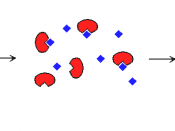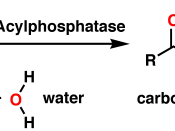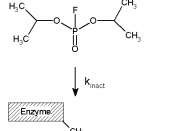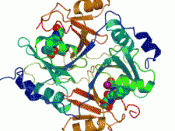Discussion/Analysis 1. If gas bubbles form then fermentation occurred. Glucose. Carbon dioxide. The enzyme didn't recognize the structure of glactose, because of the orientation of the H and OH on the carbon 4 is different than glucose. The enzyme only identifies very specific substances.
2. In order to determine how fast a reaction is occurring there must be a basis for measurement. There must also be an indicator substances to determine the change that took place. Then there must be a tool to measure the change. In this lab a spectrophotometer was used. The ABS value is the actual value and it is used to determine the rate of change.
3. The higher the concentration of the enzyme the more there are to catalyze the reaction. Taking information from graph 1 (change in mL of enzyme), the more mL of enzymes that there are the faster the reaction rate is.
It would increase until there was no substrate left available for a reaction.
4. At 5'C the reaction was slow because molecule movement gets slower when the temperature is lowered. The enzyme was broken down after it was exposed to 100'c and was unable to catalyze a reaction. At room temperature the reaction was the best, because it was not too cold and not too hot.
5. Decreasing or increasing the pH slowed the rate of reaction. The pH of 7 was the best for the reaction. If there are more H or more OH in the solution then the reaction is inhibited, because they disrupt the active site.
6. The inhibitor slowed and almost stopped the reaction rate. The inhibitor was able to bind to the enzymes active site and made it hard for it to catalyze a reaction with peroxide.
Introduction Molecules called enzymes help catalyze reactions. A substrate is the molecule on which the enzyme acts. Most enzymes are proteins that have grooves in them called active sites that recognizes the substrate. When the enzyme and substrate come together the structure of the substrate starts to be broken down. Now the substrate's bond can easily be broken.
There are several factors that change the ability of an enzyme to do its job. The effect of enzyme concentration, temperature, pH and an inhibitor were studied in this lab. The results from this study are provided in the data and results section and the analysis section of this write up.





